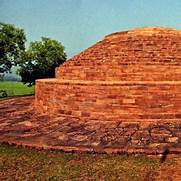Conservation Of Ancient Buddhist Site:

Chaeological Survey of India (ASI) will conserve the Ancient Buddhist site on the bank of Bhima River near Kanaganahalli (forming part of Sannati site) in Kalaburagi district, Karnataka.
- The conservation project will reset the remains of Maha Stupa retrieved in the excavation to their original positions without much ornamentation and reconstructing of fallen portions of the Ayaka platforms using newly-fabricated bricks of the same size, shape and texture.
Findings of the Excavation:
- The Edicts of Ashoka are a collection of more than thirty inscriptions on the pillars, as well as boulders and cave walls, attributed to Emperor Ashoka of the Mauryan Empire who reigned from 268 BCE to 232 BCE.
- A Maha Stupa was discovered which was referred to as Adholoka Maha Chaitya (the Great Stupa of the netherworlds) in the inscriptions and, more significantly, the stone-portrait of Emperor Ashoka, surrounded by his queens and female attendants.
- The Maha Stupa is believed to have been developed in three constructional phases – Maurya, Early Satavahana and Later Satavahana periods stretching from 3rd Century B.C. to 3rd Century A.D.
- The Stupa is believed to have been destroyed in an earthquake.
- Stupa is one of the largest of its time, the stone-portrait is considered to be the only surviving image of the Mauryan Emperor which had the inscription ‘Raya Asoko’ in Brahmi on it.
- Other Findings:
- Sculptural rendering of Jataka stories.
- The Jatakas are an important part of Buddhist art and literature.
- They describe the previous existences or births of the Buddha (the Enlightened One) when he appeared as Bodhisattvas (beings who are yet to attain enlightenment or moksha), in both human and non-human forms.
- Shatavahana monarchs and certain unique depictions of Buddhist missionaries sent by Ashoka to different parts.
- 72 drum-slabs decorated with a variety of Dharma-Chakras.
- Sculptures of Yakshas and lion. Yakshas (male nature spirits) are personifications of the natural world.
- Brahmi inscriptions with varied paleographical features.
- Brahmi script is one of the oldest writing systems, having been used in the Indian subcontinent and Central Asia during the final centuries BCE and the early centuries CE.




